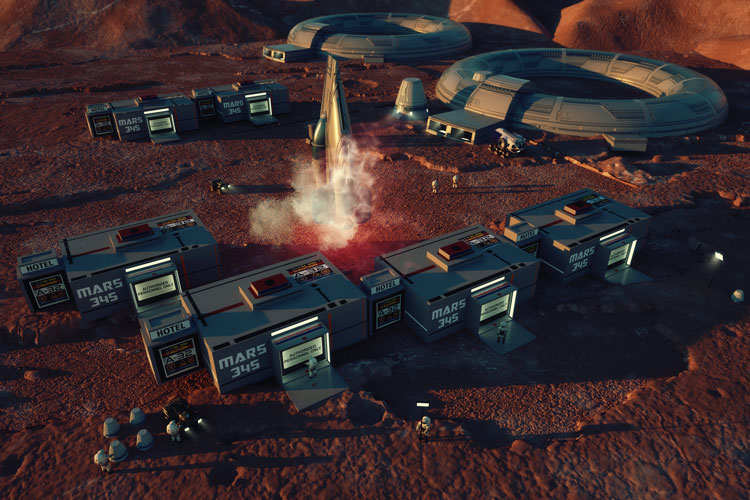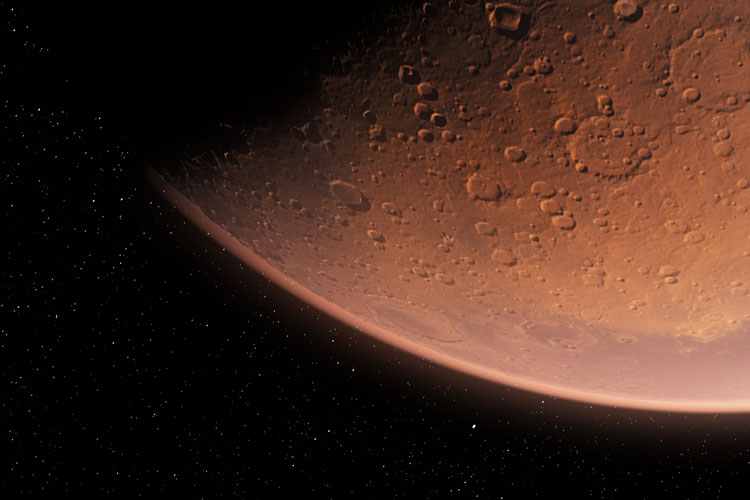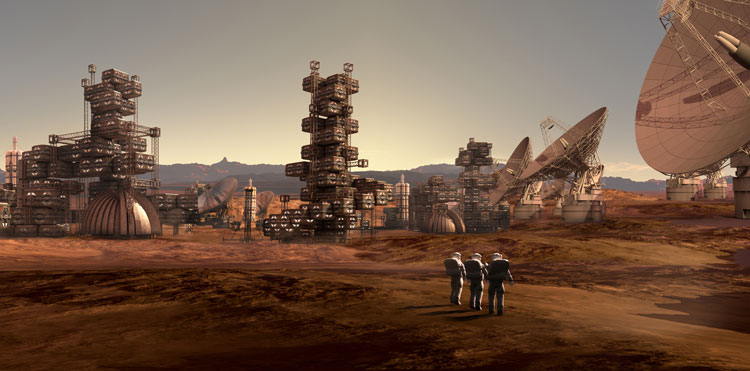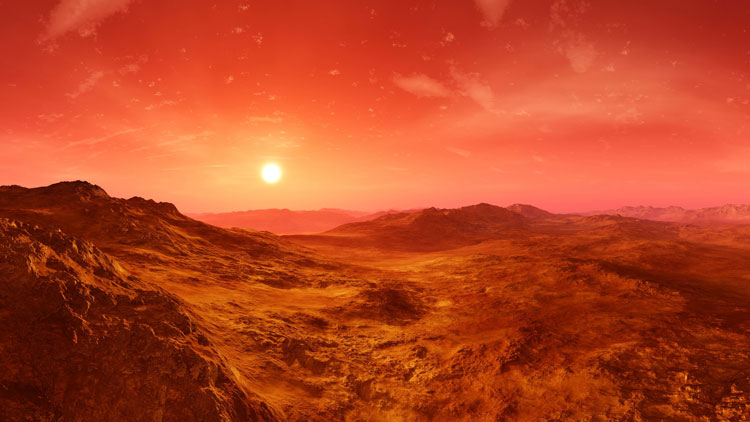
Humanity's interest in Mars dates back to ancient times, when people observed its movement across the sky and attributed various mythological meanings to it. In modern times, interest in Mars has increased due to science fiction literature and films, which presented Mars as a planet inhabited by alien creatures or ancient civilizations.
Scientific exploration of Mars began in the 20th century with the help of telescopes, probes and rovers that studied its surface, atmosphere, climate and geology (we talked about this in detail in our article here ☞). One of the main goals of these studies was to find out whether life exists on Mars or has ever existed in the past. Another important goal was to determine whether Mars could be made suitable for human life and what technologies and resources would be required. Colonization of Mars is seen as one of the ways to ensure the survival of humanity in the event of global disasters on Earth, as well as an opportunity to expand the boundaries of scientific knowledge and technological progress.
Today, Mars is one of the most studied celestial bodies; many probes and rovers have been landed on it, and they are also planning to send the first human settlers. What are the chances of finding life on Mars and what prospects does its colonization have?
Possibility of life on Mars
Factors influencing the possibility of life on Mars
Life as we know it requires certain conditions for its existence, such as the presence of liquid water, moderate temperature, atmospheric pressure, access to light and nutrients. On Mars, these conditions are very different from those on Earth, which makes life on it unlikely, but not impossible.
Atmosphere: density, composition, pressure, temperature
The atmosphere of Mars is very thin and consists primarily of carbon dioxide (95,3%), as well as nitrogen (2,7%), argon (1,6%) and traces of other gases such as oxygen, water vapor and methane.
The density of the atmosphere of Mars is on average about 0,02 kg/m³, which is 50 times less than on Earth.
Atmospheric pressure on the surface of Mars varies from 0,03 to 1,16 kPa, which is 150–6000 times less than on Earth.
The temperature of Mars' atmosphere also varies greatly depending on altitude, latitude, time of day and season. The average temperature of the Martian atmosphere is about -63 °C, the maximum is about 20 °C, and the minimum is about -153 °C.
Such conditions make Mars unsuitable for human breathing without a special spacesuit and protection from low pressure and cold.
Water: presence of liquid water, presence of ice, presence of water in the atmosphere
Liquid water on the surface of Mars is practically absent due to low pressure and temperature, which do not allow it to remain in a liquid state. However, there are signs on Mars that it was warmer and wetter in the past, with rivers, lakes and even oceans flowing on its surface. These features include the presence of ancient riverbeds, deltas, lake craters, minerals formed in the presence of water and the isotope ratio of hydrogen and deuterium in the atmosphere. It is believed that around 3,5–4 billion years ago, Mars was losing its magnetosphere, which protected it from the solar wind, and as a result lost much of its atmosphere and water. However, some water remains on Mars in the form of ice and water vapor.
Ice on Mars comes in two forms: water ice and dry ice. Water ice is made up of water molecules, while dry ice is made up of carbon dioxide molecules. Water ice on Mars occurs in the form of polar ice caps, subsurface layers, and glacial deposits.
The polar caps of Mars are the masses of ice that cover its north and south poles. They consist of a mixture of water and dry ice, with dry ice forming a thin seasonal layer that evaporates in the summer, and water ice forming a permanent layer that persists year-round. The polar caps of Mars are up to 3 km thick and contain about 70% of all the water on Mars.
Subterranean ice layers on Mars are layers of water ice that lie at varying depths below the planet's surface. They were formed as a result of the migration of water from the atmosphere into the soil in the past, when the climate of Mars was more humid. Subsurface layers of ice on Mars have been discovered by radar on board probes and rovers, and by meteorites that excavate ice to the surface.
Glacial deposits on Mars are accumulations of water ice covered with a layer of dust and gravel that take the form of glaciers, moraines and dunes. They are common in the middle and high latitudes of Mars and can be up to several hundred meters thick. Glacial deposits were formed by the accumulation of snow and ice in the past, when Mars' axis was more tilted and it received more solar radiation at the poles.
Water vapor on Mars is present in the atmosphere in very small quantities, amounting to about 0,03% of its volume. Water vapor is formed as a result of the sublimation of ice from the surface of the planet and is transported by winds to different regions. It can form clouds, fog and frost, which influence the planet's climate and weather. Water vapor on Mars also plays a role in the global water cycle, which links the planet's atmosphere, surface, and subsurface.

Existence of life on Mars
Evidence of life on Mars
Even though Mars has water in various forms, that doesn't mean it has life. Life as we know it requires not only water, but also other factors such as organic molecules, energy sources, minerals and protection from harmful influences. On Mars, these factors are either absent or present in insufficient quantities. Therefore, to date there is no convincing evidence of the existence of life on Mars, either in the present or in the past. However, there are some findings that may indicate the possibility of life on Mars, but require further study and confirmation.
One of these findings is the detection of methane in the atmosphere of Mars. Methane is a simple organic gas that is produced on Earth primarily by biological processes such as fermentation and microbial respiration. On Mars, methane has been detected using spectrometers on board probes and rovers, as well as using telescopes on Earth. The amount of methane in the Martian atmosphere varies from 0,2 to 30 parts per billion and has seasonal and regional variations.
The source of methane on Mars is still unknown, but there are several hypotheses that explain its origin. One hypothesis suggests that methane on Mars is produced by biological processes such as respiration or methanogenesis by microorganisms that may live in underground niches or in ice. This hypothesis is supported by the fact that methane on Mars has an isotopic composition close to biogenic methane on Earth, and also by the fact that methane on Mars appears and disappears in accordance with seasons and temperature, which may indicate its release by living organisms. However, this hypothesis cannot explain how microorganisms on Mars can survive in extreme conditions such as low pressure, cold, dryness, radiation and lack of oxygen.
Another hypothesis suggests that methane on this planet is produced by abiogenic processes such as geological activity, meteorite impacts, photodissociation or oxidation of organic matter. This hypothesis is supported by the fact that Mars has evidence of volcanism, tectonics, hydrothermal activity and impact craters that can generate methane. However, this hypothesis cannot explain why methane levels on Mars are so low compared to other abiogenic planets such as Venus or Titan.
Hypotheses about life forms on Mars
If there really is life on Mars, what form could it be and how has it adapted to the extreme conditions of the planet? There are several hypotheses that suggest different types of life on Mars, based on analogies with Earth or theoretical models.
One hypothesis suggests that life on Mars may be similar to life on Earth, but with some adaptations, such as the ability for anaerobic respiration, methane synthesis, radiation protection, antifreeze synthesis, and tolerance to dryness and cold. This hypothesis is based on the fact that on Earth there are so-called extremophiles – microorganisms that can live in conditions close to those on Mars, such as high salinity, low pressure, high or low temperature, high acidity or alkalinity, high radiation, etc. Examples of such extremophiles include archaea, bacteria and fungi that live in deep mines, geysers, salt lakes, glaciers and even in space. However, this hypothesis does not take into account that life on Earth evolved under more favorable conditions than on Mars, and that extremophiles on Earth still depend on other life forms to provide them with food and protection.
Another hypothesis suggests that life on Mars may be completely different from life on Earth and have different chemical bases, structures, metabolism and forms. This hypothesis is based on the fact that life is not a unique phenomenon, but the result of chemical evolution, which can proceed differently in different conditions. For example, life on Mars may use solvents other than water, such as ammonia, methane or hydrogen sulfide.
Life on Mars may use elements other than carbon, such as silicon, nitrogen or sulfur. Life on Mars may not use DNA, but other molecules that can store and transmit genetic information, such as RNA, PNA or XNA. Life on Mars may not have a cellular organization, but a non-cellular or supercellular organization, such as viruses, protocytes or slime fungi. Life on the red planet may not have organic, but inorganic or hybrid metabolism, such as chemosynthesis, photosynthesis or pyrolysis. Life on Mars may not have biomorphic, but geomorphic or technomorphic forms, such as crystals, sand roses or nanobots. However, this hypothesis does not have sufficient experimental or theoretical basis and is more speculative than scientific.
Potential for detecting life on Mars in the future
Although there is currently no conclusive evidence of the existence of life on Mars, this does not mean that it does not exist or that it cannot be found in the future. There are several possibilities that could help detect life on Mars, if there is any, or rule out its presence if there is none. These features include the following:
- Increasing the sensitivity and resolution of the instruments used to study Mars. For example, improving spectrometers, radars, microscopes, chromatographs and other instruments that can detect and analyze small amounts of organic molecules, methane, water and other potential biomarkers on Mars.
- Expanding the field of Mars exploration. For example, exploring more diverse regions of Mars, such as the polar ice caps, subsurface layers, glacial deposits, volcanoes, hydrothermal vents, and other potentially life-friendly sites. Also, exploring the deeper layers of Mars, such as the mantle and core, which may contain the heat and water necessary for life.
- Application of new methods and technologies to study Mars. For example, the use of more advanced probes and rovers that can move along the surface of Mars, drill wells, take samples, conduct experiments and transmit data. Also, the use of more powerful telescopes and satellites that can observe Mars from orbit, measure its atmosphere, magnetic field, gravity and other parameters. In addition, the use of more modern computers and algorithms that can process and interpret large amounts of data obtained from Mars exploration.
- Organization of the first human mission to Mars. For example, sending the first astronauts to Mars, who can personally explore the surface of Mars, conduct scientific experiments, establish bases and infrastructure, and communicate with Earth. Also, the creation of the first permanent colony on Mars, which could develop science, technology, culture and society on the new planet.

Colonization of Mars
Prospects for the colonization of Mars
Colonization of Mars is the process of establishing a permanent human presence on Mars, which includes transporting people and cargo between Earth and Mars, establishing bases and settlements on the surface of Mars, developing the resources of Mars, adapting to the conditions of the planet and developing science, technology, culture and society on Mars. Colonization of Mars has several goals and objectives that motivate humanity towards this ambitious project.
Development of Mars resources
One of the goals of colonizing Mars is to develop its resources, which can be useful to humanity. Mars has many resources that can be used to support life, energy production, construction, manufacturing, research and trade. For example, Mars has water in the form of ice, which can be melted and purified for drinking, agriculture, hygiene, and the production of oxygen and hydrogen. Mars has carbon dioxide in its atmosphere, which can be used to produce methane, synthetic fuels, plastics and other chemicals. Mars has metals such as iron, aluminum, magnesium, nickel and others that can be mined and processed for construction, engineering, electronics and other industries. Mars has minerals such as silicates, carbonates, sulfates and others that can be used to make glass, ceramics, cement and other materials.
Mars has solar energy that can be collected and converted into electricity, heat and light. There is geothermal energy that can be used for heating and cooling.
Mars has scientific value that can be used to study the planet, its history, geology, climate, atmosphere, magnetosphere, satellites, asteroids and other objects in the solar system.
The development of science and technology
Another goal of colonizing Mars is to develop science and technology that can contribute to human progress. Colonizing Mars requires solving a variety of scientific and technical problems that stimulate human ingenuity, creativity, and collaboration. Colonization of Mars also provides the opportunity to apply and test new scientific and technological solutions that could be useful not only for Mars, but also for Earth. For example, the colonization of Mars contributes to the development of the space industry, which includes the design, production, launch and operation of spacecraft, rockets, satellites, stations and bases. It promotes the development of biotechnology, which involves the study, modification and use of living organisms, cells, genes and molecules for medicine, agriculture, industry and the environment. Colonization of Mars is fueling the development of nanotechnology, which involves manipulating materials at the atomic and molecular level to create new properties, functions and products.
The colonization of Mars also promotes the development of information technology, which involves the collection, processing, storage, transmission and analysis of data using computers, networks, software and artificial intelligence. This promotes the development of energy technologies, which include the production, distribution and use of energy from various sources such as solar, wind, water, geothermal, nuclear fusion and others. Colonization of Mars promotes the development of environmental technologies, which include the prevention, reduction and elimination of environmental pollution, as well as the restoration and conservation of natural resources and biodiversity.
Search for new opportunities for human life
Another goal of colonizing Mars is to find new opportunities for human life. Colonization of Mars represents a unique experience for human civilization that could bring many benefits. This could give humanity a new home that could be an alternative or complement to Earth, especially in the event of global disasters such as asteroid strikes, nuclear wars, pandemics, climate change and others. Colonization of Mars could provide humanity with a new challenge that could stimulate the development of individuals, society and culture, especially in conditions of isolation, limitation and adaptation to a new environment.
Colonization of Mars could provide humanity with a new horizon that could be a source of exploration, learning, and discovery, especially regarding space, Mars, life, and ourselves. It can expand our knowledge about the Universe, its origin, structure, laws and mysteries. Colonization of Mars can help us understand how Mars was formed and developed, what processes are happening on it now, and what prospects it has in the future. This could help us answer the question of whether there is life on Mars or other planets, how it originated, how it adapted, how it interacts, and how it evolves.

Problems and risks of colonizing Mars
Colonizing Mars is not only a dream and an adventure, but also a complex and dangerous task that involves many challenges and risks that need to be considered and overcome. Colonization of Mars involves the following problems, difficulties and risks.
Problems and risks of transportation between Earth and Mars
The problem is the flight duration, which ranges from 6 to 9 months one way, depending on the position of the planets and the chosen trajectory. Flight duration can cause physical and psychological problems for astronauts, such as poor health, decreased muscle mass and bone density, increased radiation exposure, stress, depression, boredom and conflict. Flight duration also limits the number of people and cargo that can be carried at one time, and increases the cost and complexity of the mission.
Other problems and risks of transportation between Earth and Mars are the reliability and safety of spacecraft and rockets, which can be subject to breakdowns, accidents, collisions, attacks and other unforeseen situations.
Problems and risks of developing Mars resources
The challenge is the difficulty and cost of extracting, processing, using and transporting Mars' resources, which may be limited, sparse, polluted or difficult to access. The problem may be the difficulty and cost of producing and importing goods and services on Mars that may be necessary for life, development and exchange on this planet. There is a risk that it would be very difficult and expensive to create and maintain an economic system on Mars that could provide stability, efficiency, equity, and growth on Mars.
Problems and risks of installing bases and settlements on the surface of Mars
The problem is the need to provide life support, energy supply, communications, protection, transport, storage, maintenance and repair of bases and settlements on Mars.
This includes the need to adapt to the conditions of Mars, such as low pressure, low temperature, high radiation, strong winds, dust storms, uneven terrain and others. There is a need to maintain environmental and ethical responsibility for the impact on the environment and potential life on Mars.
Other problems and risks of establishing bases and settlements on the surface of Mars are conflicts and cooperation between different groups and organizations that may have different interests, goals, values and rules on Mars.

Mars is a unique planet that has much in common with Earth, but also many differences. Mars attracts the attention of humanity with its beauty, mystery and potential. One of the most fascinating mysteries of Mars is the possibility of life on it. Mars has water in various forms, but not enough to support life as we know it.
To date, there is no convincing evidence of the existence of life on Mars, either in the present or in the past. But this does not exclude the possibility that there may be life on Mars that is different from Earth, or that there was life on Mars in the distant past, when it was warmer and wetter.
In the future, there are opportunities to detect life on Mars, if it exists, or exclude its presence, if it does not exist. To do this, we need to continue to study Mars using various tools, methods and technologies, as well as organize the first human mission to Mars.
Further study of the red planet will help answer the main question of humanity: is it possible to make Mars suitable for human life and what technologies and resources will be required for this.
Mars is a planet that could become a new home for humanity, or a new source for scientific discoveries. This planet deserves our attention and study.










